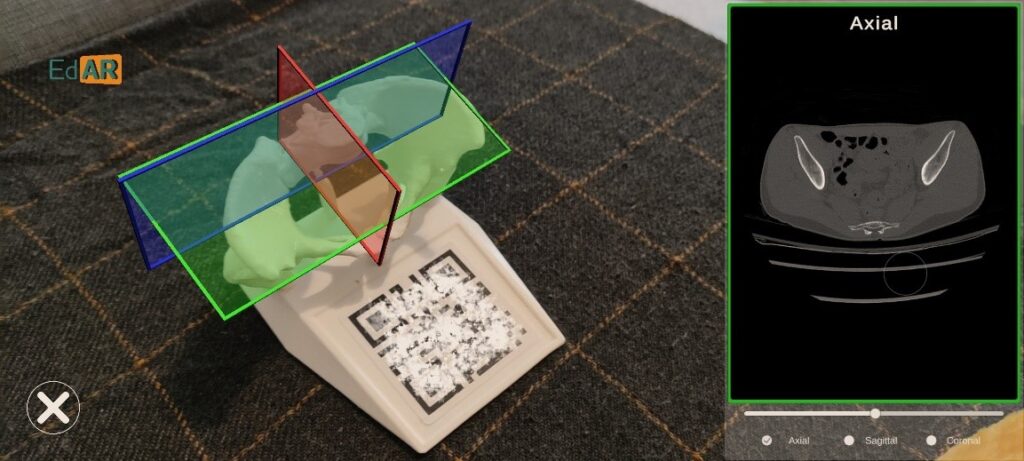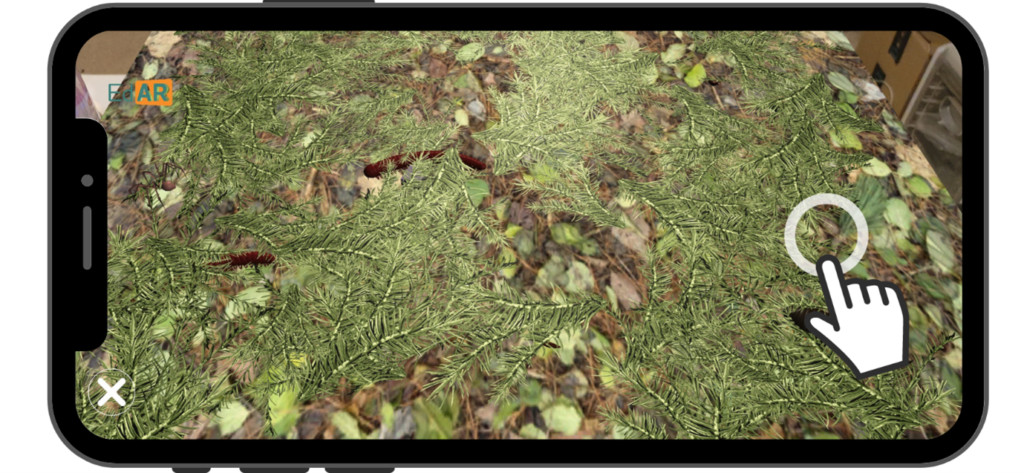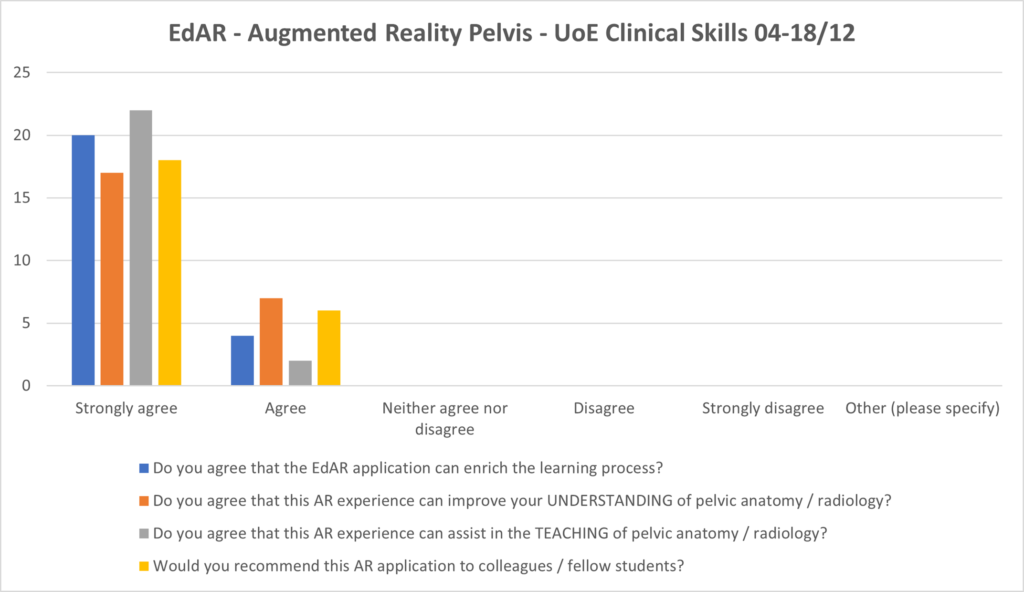
Dr Danai Korre and Professor Andrew Sherlock explore how three pilot educational AR applications can promote digital technology in teaching. This extra post is part of the Innovation in Science Teaching theme.
The rapidly advancing technology of Augmented and Mixed Reality (AR/MR) allows for interactions between real objects and virtual objects. By using AR, students can experience and interact with physical objects overlayed with 3D holograms and explanations, simply using a smartphone, tablet, or AR headset. This makes AR highly effective when teaching geometric and spatial concepts, often found in science, technology, engineering, and math. However, if you are an educator, it requires expertise. Not all educators possess the funding or knowledge to leverage the power of AR to create a unique learning experience that makes the most of the AR technology.
In order to address these issues, we applied successfully for a Principal’s Teaching Award Scheme (PTAS) in 2019. This project aimed to address the ‘adoption gap’ by looking to identify and develop three pilot educational AR applications to promote digital technology in teaching.
By the end of the project, we achieved the following objectives:
- Developed and evaluated three pilot apps,
- Supported AR app production by student-led teams such as Formula Student.
- Surveyed the University’s current stock of AR/MR hardware available for teaching.
- Determined in which subject areas AR/MR offers most benefits [1].
The PTAS project demonstrated real interest around the use of AR for educational activities, and led to a successful proposal funded by EIT Digital, with a consortium of partners from across Europe: Babcock, Theorem Solutions, DTx Colab and the University of Minho.
Out of the EIT Digital project, a spin out company, EdAR Ltd, was formed with the aim of bridging the gap between educators and the capabilities of augmented reality in a sustainable and cost-effective way. The model is to partner with subject matter experts to develop engaging AR experiences for broadly applicable subjects. These experiences are then sold to the educational market, with royalties being passed back to the partner, creating a cost-effective way to bring engaging AR experiences into the curriculum.
AR experience examples
As EdAR, we developed numerous AR experiences, two of which were included in the Learning & Teaching Conference 2021 workshop “Augmented reality, STEM and remote learning”. The two experiences are the ‘Pelvis Experience’ and the ‘Ecology Experience’.
The ‘Pelvis Experience’ is an AR-enhanced learning experience developed in collaboration with The University of Edinburgh Medical School. The aim of this experience is to help teach students the orientation and position of CT scan images for complex parts of human anatomy such as the pelvis [2].
The physical 3D model of the pelvis can be examined and, with the help of AR, the user can control the axial, coronal and sagittal planes that are used to transect the body, to see the corresponding scan images.
There are two sizes for the pelvis’s physical models, a large one and a mini one that can be used by the student. There is also a version without the physical model where the pelvis is displayed on a screen.

The ‘Ecology Experience’ is an AR learning experience developed in collaboration with the School of Biological Sciences. The aim of this experience is to have students explore different forest floor environments, and count and identify species found within a defined search area. By using this experience, students are able to form and test hypotheses by collecting data and use dichotomous key to identify species.

What have been the benefits to student learning?
The distinctive technological characteristics of mobile learning deliver positive pedagogical affordances. Previous results with mobile serious games support this [3]. Klopfer and Squire [4] mention that the most frequently reported characteristics of mobile learning are “portability, social interactivity, context, and individuality”, with portability as the most distinctive feature that automatically sets apart mobile learning from other learning methods [4] [5]. These positive pedagogical characteristics are further enhanced by the use of AR which gives the learners flexibility and makes complex spatial concepts more understandable.
In an effort to collect insights regarding the use of AR for educational activities, we ran a workshop. The cohort consisted of 19 undergraduate medical students, three Postgraduate trainees and two junior trainers (non – consultant) who demoed the Pelvis Experience using our 3D printed models.

The participants were asked if they used AR in the past. The majority of participants (16) never used AR in the past while 8 had.
In the question, “Do you agree that the EdAR application can enrich the learning process?”, 20 (83.33%) of the participants answered that they strongly agree with the statement, and four (16.67%) answered that they agree with the statement.

Participants were asked to give additional comments on the Pelvis Experience, some of which are given below:
Has a lot of potential for learning the anatomy of complex 3D structures, given then the majority of current teaching mediums are 2 dimensional.
Very useful system, with huge scope. Could also be very useful for patient information in consent. Also useful in considering intra-operative prosthesis placement and design.
This will help me understand complex 3D relations relevant to hip surgery.
Very interesting for future anatomy teaching.
Would be really helpful in putting anatomy into practice.
Summary
Immersive technologies, such as AR and VR, are a promising addition to EdTech. Due to their nature, much like serious games, they can offer an engaging and safe experience that can mitigate distance and cost barriers. The fact that these technologies can mitigate distance barriers came into focus during the pandemic with the interest in investing on mixed reality educational applications skyrocketing. Especially in higher education which is our focus, AR/VR can help students understand abstract concepts and practise in a safe sandbox environment. Also, the latest technological advancements will render the AR/VR dedicated devices more affordable which will make them more accessible. Thus, we are hoping to continue building upon the success of our project and offer a new paradigm for remote learning.
References
[1] A. Sherlock, A. Cunha, A. Pontes, M. Stowe and N. Lines, EdAR start-up proposal, 2019. [2] Case courtesy of Dr Matthew Lukies, Radiopaedia.org, rID: 51471. [3] Korre, D., 2019. Usability evaluation of spoken humanoid embodied conversational agents in mobile serious games. PhD. University of Edinburgh. [4] Klopfer, E., Squire, K., 2008. Environmental detectives-the development of an augmented reality platform for environmental simulations. Educ. Technol. Res. Dev. 56, 203–228. https://doi.org/10.1007/s11423-007-9037-6 [5] Park, Y., 2011. A pedagogical framework for mobile learning: Categorizing educational applications of mobile technologies into four types. Int. Rev. Res. Open Distance Learn. 12, 78–102. https://doi.org/10.3394/0380-1330(2006)32Danai Korre
Dr Danai Korre is a Research Associate in Augmented and Virtual Reality at The University of Edinburgh. She has an MSc in Digital Media, and holds a PhD in Human-Oriented Artificial Intelligence, User Experience (UX) research and Data Science with a focus on embodied conversational agents and mobile serious games. She has more than 8 years of experience in EdTech, and is a review editor in mobile and ubiquitous computing. Her research interests involve serious games, immersive technologies, VR/AR/MR, human computer interaction, human-oriented artificial intelligence, EdTech, embodied conversational and pedagogical agents, ubiquitous computing, and usability engineering.
Andrew Sherlcok
Professor Andrew Sherlock is the Director of Data-driven Manufacturing at the National Manufacturing Institute Scotland (NMIS), and Professor of Practice at the University of Strathclyde. In 2006, he founded ShapeSpace Ltd, a spin-out from The University of Edinburgh, to commercialise 3D search-by-shape technology, initially developed as a 3D search engine for components and subsequently enhanced to allow analysis of assemblies. This technology has been deployed at a number of large manufacturers in automotive, aerospace and industrial equipment industries where the ability to do analytics on component portfolios and large numbers of bills of materials has uncovered significant cost savings within the supply chain. In 2020, he founded EdAR (Software) Ltd, another spin-out from The University of Edinburgh, applying augmented reality to educational materials for engineering, medicine and other STEM subjects. Between 2016 and 2019, he was the Royal Academy of Engineering (RAEng) Visiting Professor in Design for Product Profitability, and from 2020 to 2021 as Industrial Chair of Data-driven Manufacturing, both at The University of Edinburgh.



